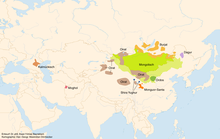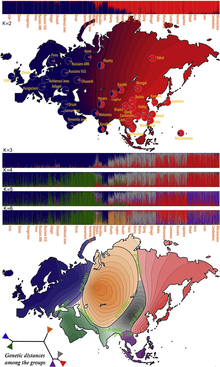
The Göktürks, Türüks, Celestial Turks or Blue Turks, alternatively Great Turks or Root Turks were a nomadic confederation of Turkic peoples in medieval Inner Asia. The Göktürks, under the leadership of Bumin Qaghan and his sons, succeeded the Rouran Khaganate as the main power in the region and established the First Turkic Khaganate, one of several nomadic dynasties that would shape the future geolocation, culture, and dominant beliefs of Turkic peoples.
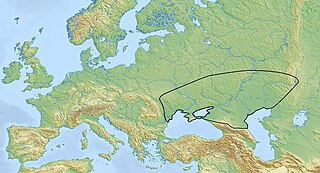
The Yamnaya culture or the Yamna culture, also known as the Pit Grave culture or Ochre Grave culture, is a late Copper Age to early Bronze Age archaeological culture of the region between the Southern Bug, Dniester, and Ural rivers, dating to 3300–2600 BCE. It was discovered by Vasily Gorodtsov following his archaeological excavations near the Donets River in 1901–1903. Its name derives from its characteristic burial tradition: Я́мная is a Russian adjective that means 'related to pits ', as these people used to bury their dead in tumuli (kurgans) containing simple pit chambers.
The Afanasievo culture, or Afanasevo culture, is an early archaeological culture of south Siberia, occupying the Minusinsk Basin and the Altai Mountains during the eneolithic era, c. 3300 to 2500 BCE. It is named after a nearby mountain, Gora Afanasieva in what is now Bogradsky District, Khakassia, Russia, first excavated by archaeologist Sergei Teploukhov in 1920-1929. Afanasievo burials have been found as far as Shatar Chuluu in central Mongolia, confirming a further expansion about 1,500 km beyond the Altai mountains. The Afanasievo culture is now considered as an integral part of the Prehistory of Western and Central Mongolia.
Genetics and archaeogenetics of South Asia is the study of the genetics and archaeogenetics of the ethnic groups of South Asia. It aims at uncovering these groups' genetic histories. The geographic position of the Indian subcontinent makes its biodiversity important for the study of the early dispersal of anatomically modern humans across Asia.

The Altai people, also the Altaians, are a Turkic ethnic group of indigenous peoples of Siberia mainly living in the Altai Republic, Russia. Several thousand of the Altaians also live in Mongolia and China but are not officially recognized as a distinct group and listed under the name "Oirats" as a part of the Mongols, as well as in Kazakhstan where they number around 200. For alternative ethnonyms see also Tele, Black Tatar, and Oirats. During the Northern Yuan dynasty, they were ruled in the administrative area known as Telengid Province.

Tungusic peoples are an ethnolinguistic group formed by the speakers of Tungusic languages. They are native to Siberia, China, and Mongolia.
The Tagar culture was a Bronze Age Saka archeological culture which flourished between the 8th and 1st centuries BC in South Siberia. The culture was named after an island in the Yenisei River opposite Minusinsk. The civilization was one of the largest centres of bronze-smelting in ancient Eurasia.
Tianyuan man are the remains of one of the earliest modern humans to inhabit East Asia. In 2007, researchers found 34 bone fragments belonging to a single individual at the Tianyuan Cave near Beijing, China. Radiocarbon dating shows the bones to be between 42,000 and 39,000 years old, which may be slightly younger than the only other finds of bones of a similar age at the Niah Caves in Sarawak on the South-east Asian island of Borneo.

In the course of the peopling of the World by Homo sapiens, East Asia was reached about 50,000 years ago. The "recent African origin" lineage of 70 kya diverged into identifiable East Eurasian and West Eurasian lineages by about 50 kya. This early East Asian lineage diverged further during the Last Glacial Maximum, contributing outgoing from Mainland Southeast Asia significantly to the peopling of the Americas via Beringia about 25 kya. After the last ice age China became cut off from neighboring island groups. The previous phenotypes of early East Asians became either replaced or prevailed among more geographically distant groups.
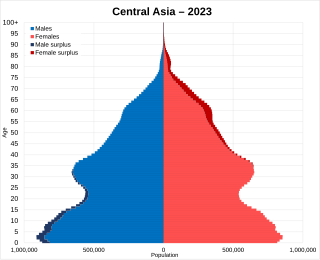
The nations which make up Central Asia are five of the former Soviet republics: Kazakhstan, Kyrgyzstan, Turkmenistan, Tajikistan and Uzbekistan, which have a total population of about 76 million. Afghanistan is not always considered part of the region, but when it is, Central Asia has a total population of about 122 million (2016); Mongolia and Xinjiang is also sometimes considered part of Central Asia due to its Central Asian cultural ties and traditions, although geographically it is East Asian. Most central Asians belong to religions which were introduced to the area within the last 1,500 years, such as Sunni Islam, Shia Islam, Ismaili Islam, Tengriism and Syriac Christianity. Buddhism, however, was introduced to Central Asia over 2,200 years ago, and Zoroastrianism, over 2,500 years ago.
Population genetics research has been conducted on the ancestry of the modern Turkish people in Turkey. Such studies are relevant for the demographic history of the population as well as health reasons, such as population specific diseases. Some studies have sought to determine the relative contributions of the Turkic peoples of Central Asia, from where the Seljuk Turks began migrating to Anatolia after the Battle of Manzikert in 1071, which led to the establishment of the Anatolian Seljuk Sultanate in the late 11th century, and prior populations in the area who were culturally assimilated during the Seljuk and the Ottoman periods.

The Slab-grave culture is an archaeological culture of Late Bronze Age and Early Iron Age Mongolia. The Slab-Grave culture formed one of the primary ancestral components of the succeeding Xiongnu, as revealed by genetic evidence. The ethnogenesis of Turkic peoples and the modern Mongolian people is, at least partially, linked to the Slab-Grave culture by historical and archaeological evidence and further corroborated by genetic research on the Slab Grave remains.
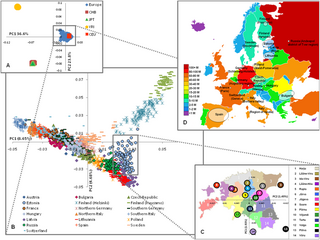
Genetic studies show that Russians are closest to Poles, Belarusians, Ukrainians and to other Slavs as well as to Estonians, Latvians, Lithuanians, Hungarians.

In archaeogenetics, the term Ancient North Eurasian (ANE) is the name given to an ancestral component that represents the lineage of the people of the Mal'ta–Buret' culture and populations closely related to them, such as the Upper Paleolithic individuals from Afontova Gora in Siberia. Genetic studies also revealed that the ANE are closely related to the remains of the preceding Yana Culture, which were dubbed as 'Ancient North Siberians' (ANS), and which either are directly ancestral to the ANE, or both being closely related sister lineages, sharing a common ancestral source population. The Ancient North Eurasians are deeply related to Paleolithic and Mesolithic European hunter-gatherers, but also derive a small amount of their ancestry from a deep East Eurasian source, which they received in Siberia.
This article summarizes the genetic makeup and population history of East Asian peoples and their connection to genetically related populations, as well as Oceanians and partly, Central Asians and South Asians, which are collectively referred to as "East Eurasians" in population genomics.

The Scytho-Siberian world was an archaeological horizon that flourished across the entire Eurasian Steppe during the Iron Age, from approximately the 9th century BC to the 2nd century AD. It included the Scythian, Sauromatian and Sarmatian cultures of Eastern Europe, the Saka-Massagetae and Tasmola cultures of Central Asia, and the Aldy-Bel, Pazyryk and Tagar cultures of south Siberia.

In archaeogenetics, the term Western Steppe Herders (WSH), or Western Steppe Pastoralists, is the name given to a distinct ancestral component first identified in individuals from the Chalcolithic steppe around the turn of the 5th millennium BC, subsequently detected in several genetically similar or directly related ancient populations including the Khvalynsk, Sredny Stog, and Yamnaya cultures, and found in substantial levels in contemporary European, West Asian and South Asian populations. This ancestry is often referred to as Yamnaya ancestry, Yamnaya-related ancestry, Steppe ancestry or Steppe-related ancestry.

The genetic history of Africa summarizes the genetic makeup and population history of African populations in Africa, composed of the overall genetic history, including the regional genetic histories of North Africa, West Africa, East Africa, Central Africa, and Southern Africa, as well as the recent origin of modern humans in Africa. The Sahara served as a trans-regional passageway and place of dwelling for people in Africa during various humid phases and periods throughout the history of Africa.
The Chandman culture, also known as Chandmani culture, was a nomadic culture that existed in northwestern Mongolia and southern Siberia during the Iron Age, and is also known as the "Sagly-Bazhy culture" on the Russian side of the frontier. It is associated with the Eastern Scythian/Saka horizon, and is part of the more general Saka Uyuk culture.

In archaeogenetics, the term Ancient Northern East Asian (ANEA), also known as Northern East Asian (NEA), is used to summarize the related ancestral components that represent the Ancient Northern East Asian peoples, extending from the Baikal region to the Yellow River and the Qinling-Huaihe Line in present-day central China. They are inferred to have diverged from Ancient Southern East Asians (ASEA) around 20,000 to 26,000 BCE.
